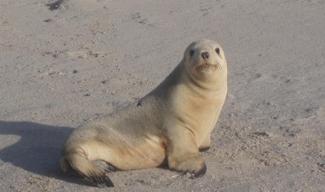
The Australian sea lion is one of seven sea lion species. They are the only carnivorous aquatic mammal endemic to Australian waters and are extremely rare.
They are protected by the Environment Protection and Biodiversity Conservation Act 1999.
Biology
Australian sea lions are unique marine mammals that spend long periods at sea, usually alternating between diving to find food and resting on the surface of the water. They feed on squid, octopus, fish and crustaceans and are able to dive to great depths in search of food.
Australian sea lions breed on the coast of the Australian mainland and near-shore islands. Females of this species will generally only breed and produce pups on the exact beach where they were born.
Fishing and Australian sea lions – how they interact
Australian sea lions can interact with fishing boats that use gillnet gear.
An ‘interaction’ is any physical contact a person, boat or fishing gear has with a protected species that causes the animal stress, injury or death. Interactions with Australian sea lions can happen when they dive to feed on fish which have been caught and get trapped in the nets.
Monitoring interactions
AFMA collects data on interactions with protected species through our monitoring programs.
- Logbooks – All fishers are required to report any interactions they have through their logbooks.
- Observers – Observers are AFMA officers who travel on Australian fishing boats to collect biological data and make environmental observations which contributes to the monitoring of fishing interactions with protected species.
- Electronic monitoring – AFMA has electronic monitoring systems on some fishing boats. These systems have sensors linked to surveillance cameras that record fishing activity including bycatch of dolphins / Australian sea lions. These recordings can then be collected and monitored by AFMA to help management understand the nature and extent of these interactions.
Links
How AFMA and industry minimise interactions
The Commonwealth Fisheries Marine Mammal Working Group has been established to provide advice to AFMA on marine mammal management arrangements across all Commonwealth managed fisheries.
The Working Group has been structured to elicit the best possible advice from a wide variety of stakeholder groups including marine mammal scientists, the commercial fishing industry, the conservation sector, recreational / charter fishers and members from government agencies such as AFMA, the Department of the Environment and Energy and the Department of Agriculture and Water Resources. The Working Group also has an independent Chair.
AFMA implemented the Australian Sea Lion Management Strategy in 2010. It helps prevent the accidental deaths of Australian sea lions within the Gillnet Hook and Trap Sector of the Southern and Eastern Scalefish and Shark Fishery. The strategy includes area closures around every breeding colony of Australian sea lions in South Australia to prevent gillnets being set near these colonies.
It also includes seven separate management zones which span from the South Australia and Western Australia border across to the Coorong region near the mouth of the Murray River. Each of the seven management zones have strict limits on the number of sea lion interactions which can occur before gillnetting will be prohibited. In the event that the limits for a zone are reached an 18 month ban on gillnetting in the zone is implemented to allow sea lion colonies in the area time to recover.
In 2011, AFMA closed a large area off the coast of the Coorong region in South Australia to gillnet fishing after an increase in reported interactions with dolphins.
Protected species that are identified as high risk bycatch species are dealt with through bycatch and discard workplans for each fishery. The workplans are integrated into the management arrangements for each fishery, and are reviewed every 12 months and formally renewed every two years.
Read more about bycatch and discarding workplans.